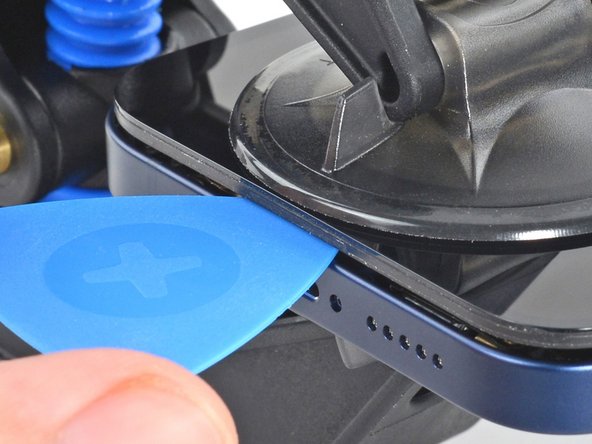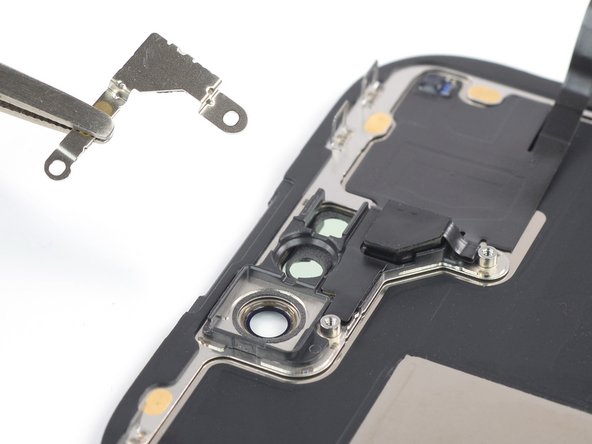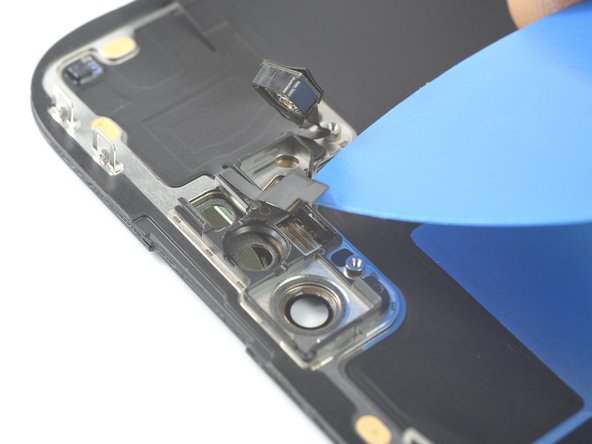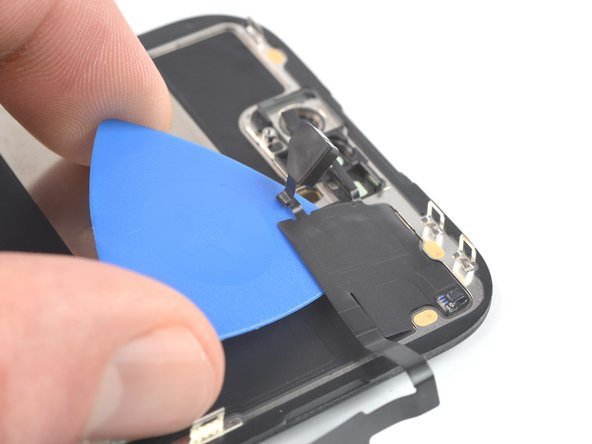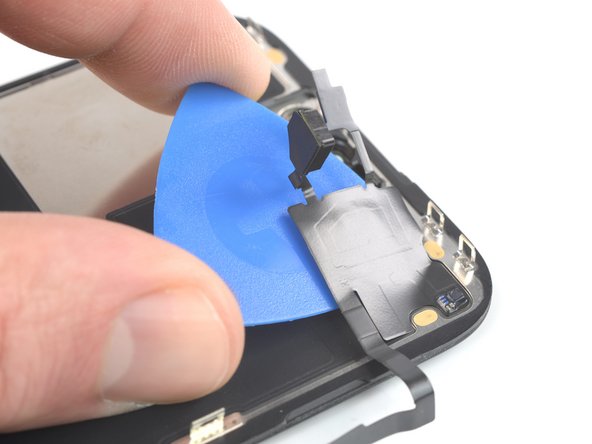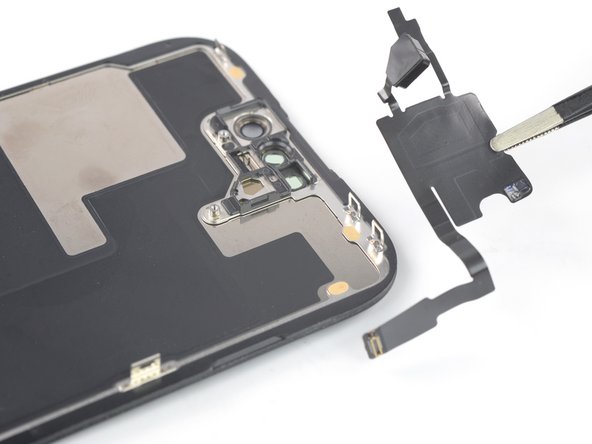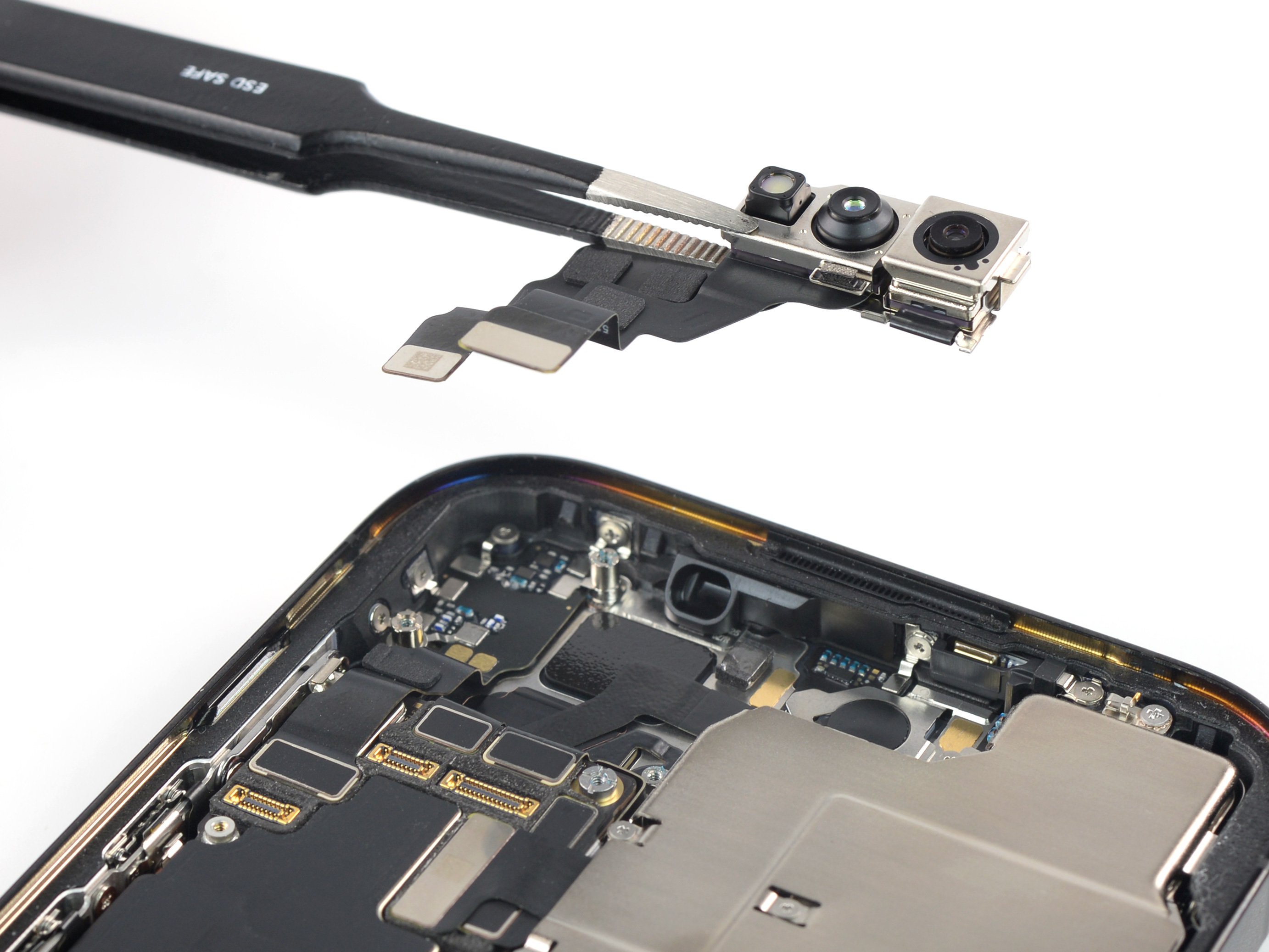iPhone 14 Pro Screen Replacement
Duration: 45 minutes
Steps: 29 Steps
Heads up! Before you pop open your device, make sure to drain the battery down to under 25% for a safer repair experience.
Got a cracked iPhone 14 Pro screen that’s unresponsive or not showing anything when powered on? This guide will help you bring your phone back to life with a brand-new screen, aka display assembly. We used the A2890 (international) model for this walkthrough. If your iPhone 14 Pro is a different version, some visuals might differ, but the steps remain the same. For safety, make sure to drain your battery below 25% before you start taking things apart — this lowers the chance of fire if the battery gets accidentally damaged. If your battery looks swollen, handle it with extra care. Quick heads up: on iOS 17.6 and earlier, True Tone and auto brightness won’t work after replacing the screen, even with a genuine Apple display. Face ID also won’t work unless your phone is running iOS 15.2 or later. For iOS 18 and up, you can use Apple’s Repair Assistant to calibrate your new screen and get True Tone back on genuine Apple screens. Remember to grab replacement adhesive to secure the screen when putting your iPhone back together. Keeping your phone water-resistant depends on how well you apply the new adhesive, but just so you know, your device will lose its official IP (Ingress Protection) rating after this repair.
Step 1
- Hit that power button and turn off your iPhone before you get hands-on.
- Unscrew the two pentalobe P2 screws (6.8 mm, bottom edge)—they’re small, but mighty. Keep them safe!
Step 2
Pushing your opening pick in too far can mess up your device — so let’s keep things safe by marking your pick to avoid any accidental damage.
Feel free to mark all the corners of your pick with different measurements for extra precision.
Another trick: tape a coin to your pick about 3 mm from the tip to keep your depth in check.
- Grab your trusty permanent marker and measure out 3 mm from the tip of the opening pick. Give it a little mark so you know where to go!
Step 3
Put on those safety glasses to keep your peepers safe from any sneaky glass shards that might escape during the repair adventure!
Got a cracked iPhone screen? Slap some tape over the glass to keep those shards from going rogue and save your fingers from surprise pokes while you work.
When the suction cup refuses to cooperate, go ahead and glue it right onto the screen—sometimes you just have to get creative!
- Cover the iPhone's screen completely by layering strips of clear packing tape, overlapping them like a pro to keep everything in place.
- If the suction cup refuses to cooperate in the next steps, no worries! Just fold a sturdy piece of tape (like duct tape) into a handy little handle and use that to lift the screen instead.
Tools Used
Step 4
In the next three steps, we'll show you how to use the Anti-Clamp, our nifty tool that makes opening up your device a breeze. If you’re not rocking the Anti-Clamp, no worries! Just skip ahead three steps for another way to get it done.
Want to master the Anti-Clamp? Check out our handy guide for all the deets!
If your iPhone's surface feels like it's auditioning for a slippery slide, just grab some tape to add a bit of grip for the Anti-Clamp. Easy peasy!
- Give that blue handle a gentle pull—this unlocks the Anti-Clamp’s arms.
- Slide the arms over the left or right edge of your iPhone, whichever side feels right.
- Line up the suction cups close to the bottom edge—one hanging out on the front, one chilling on the back.
- Squeeze those cups together so they stick right where you want them.
Step 5
- Grab the blue handle and pull it forward to lock those arms in place.
- Give the handle a full 360-degree spin clockwise, or keep going until the suction cups start to stretch a bit.
- Keep an eye on the suction cups — they should stay lined up. If they start to drift, just loosen them a touch and realign the arms before moving on.
Step 6
Take it easy! Just turn a quarter of the way and then chill for a minute before the next twist. Let the Anti-Clamp and a little patience do the heavy lifting for you.
Want the full scoop on using a hair dryer like a pro? Dive into this guide.
If the Anti-Clamp isn’t making enough space, just warm it up a bit more and give the handle a quick quarter turn.
- Set your iPhone on a solid surface like a hefty hardcover book, so it can chill hands-free and lay flat—this will make the next steps a breeze!
- Grab a hair dryer and warm up the bottom edge of your iPhone. It should get just toasty enough to feel a bit too hot to touch.
- Hang tight for a minute to let the adhesive loosen up and create a little opening for us.
- Once the Anti-Clamp does its magic and creates a nice gap, slide an opening pick under the screen's plastic bezel.
- Feel free to skip the next two steps.
Tools Used
Step 7
Don't keep your hair dryer in one spot for too long – it’s like giving it a timeout. Move it around to avoid overheating!
Got your suction handle ready? Great! Follow the next couple of steps to gently pop that screen loose.
- Grab a hair dryer or heat gun, and give the bottom edge of your iPhone a little love for about 90 seconds, or until it feels just a bit too hot to touch. This will help soften the adhesive and make the next steps smoother. Remember, don’t burn yourself!
Tools Used
Step 8
That watertight adhesive holding your screen in place is seriously tough—breaking that first little gap takes some real muscle. If you're stuck trying to pry it open, crank up the heat a bit, then gently rock the screen up and down to loosen the glue until you can slip your tool in easily.
- Grab a suction handle and stick it to the bottom edge of the screen—just steer clear of the glass's very edge.
- With a firm grip, pull up on the suction cup to create a tiny gap between the screen and the frame.
- Now, slide an opening pick into that gap beneath the screen's plastic bezel.
Tools Used
Step 9
- Grab your hair dryer and warm up the right side of your iPhone—the one with the power button—for about 90 seconds, or until the screen feels a bit too toasty for comfort.
Tools Used
Step 10
Be careful not to insert your pick more than 3 mm, or you might end up accidentally nudging some sensitive parts inside!
- Start by gently sliding the opening pick around the bottom right corner of your iPhone to break free that sticky adhesive.
- Keep the pick moving up along the right edge of the iPhone, making your way to the top right corner.
- Once you reach the top right corner, leave the pick there, but don't stop just yet!
Step 11
- Grab a hair dryer and warm up the top edge of your iPhone for about 90 seconds, or until it feels just a bit too toasty to comfortably touch.
Tools Used
Step 12
Keep your pick shallow—no deeper than 3 mm—or those sensors up top might get a little cranky.
- Carefully slide the opening pick along the top right corner of the iPhone to break the seal of the adhesive.
- Keep the pick in place at the top left corner before moving on to the next step.
Step 13
- Grab a hair dryer and gently warm up the left edge of your iPhone for about 90 seconds—or until it feels just a little too hot to touch. It's like giving your phone a mini spa treatment. Just don't burn yourself, okay?
Tools Used
Step 14
Watch out for those fragile cables snuggled along the left edge of your iPhone! It’s best to keep your pick away from this area to avoid any accidental damage to those little guys.
Step 15
Watch out! The cables hugging the left edge are super easy to nick with a pick. Use this alternate method to carefully loosen the left adhesive instead.
Slowly apply a twisting motion to ease things apart.
If the adhesive is being stubborn, just warm up the left edge a bit and try again.
- Place a second opening pick in the bottom left corner of the iPhone.
- Gently twist both picks at the same time until the left edge pops free.
Step 16
No handy surface to prop your screen on? No worries—your suction handle doubles as a perfect little stand!
- Take the suction handle off the screen and set it aside.
- Flip your iPhone so the right side is facing you.
- Open up your iPhone by gently swinging the screen up from the right side, like opening a book.
- Prop the screen up against something to keep it steady while you work on the phone.
- When putting it back together, line up the screen with the top edge, get the clips aligned, and carefully press the top down before snapping the rest of the screen in. If it’s not snapping in place, double-check the clips around the screen to make sure they’re not bent.
Tools Used
Step 17
Keep an eye on every screw during this repair and make sure each one goes back to its exact home to keep your iPhone safe and sound.
- Grab your trusty Y000 screwdriver and carefully take out the eight screws holding down the battery connector cover.
- When putting everything back together, this is a perfect moment to power on your iPhone and make sure all the functions are working smoothly before sealing the screen back in place. Remember to power it down completely again before continuing.
- Five screws measuring 1.3 mm long
- Two screws measuring 1.6 mm long
- One screw measuring 1.9 mm long
Step 18
- Grab the connector cover with your tweezers and glide it down—think of it as a tiny sled ride past the flex cables.
- Lift the connector cover off and set it aside like a champ.
Tools Used
Step 19
Be gentle with that black silicone seal around this and other board connections! It’s like a cozy blanket keeping your device safe from pesky water and dust. Treat it right, and your gadget will thank you with a longer life!
- Grab the pointy end of your spudger and gently pry the battery cable connector straight up from its socket to disconnect it.
- Once free, bend the connector a little away from the logic board so it doesn’t accidentally touch the socket and send power back into the phone while you’re working.
Tools Used
Step 20
- Grab the pointy end of your spudger and gently pry the first display cable connector straight up to unplug it from its socket.
- When reconnecting press-fit connectors like this one, line up one side carefully and press down until you hear a click, then do the same on the other side. Avoid pressing down the middle to keep those pins happy and avoid any permanent damage.
Tools Used
Step 21
- Grab the pointy end of your trusty spudger and gently pry the second display cable connector straight up to unplug it from its socket. Easy does it!
Tools Used
Step 22
- Carefully take off the screen.
- Clean the areas that need it with isopropyl alcohol (90% or higher), then slap on some fresh adhesive where it’s needed.
- When putting everything back together, feel free to pause here if you want to swap out the screen adhesives.
Step 23
The next few steps will guide you through the process of moving the front sensor assembly to your new screen. If your replacement screen already has the assembly attached, feel free to breeze past these steps.
- Grab your PH000 screwdriver and carefully unscrew the two tiny 1.4 mm screws holding the sensor assembly bracket in place. Nice and steady!
Step 24
- Grab your tweezers (or just use your fingers if you're feeling bold) and lift out the front sensor assembly bracket.
Tools Used
Step 25
You can use a hair dryer, heat gun, or hot plate to warm things up, but take it easy—overheating can mess with the display, so keep it cool and controlled.
- Warm up your iOpener and let it chill (well, heat) on the top edge of the screen for about two minutes.
Tools Used
Step 26
- Slide an opening pick between the proximity sensor and its cozy little nook on the screen.
- Give it a gentle lift with the pick to nudge the proximity sensor away from the screen.
Step 27
- Slide an opening pick between the ambient light sensor and its cozy little spot on the screen.
- Gently pry up with the pick to detach the ambient light sensor from its screen buddy.
Step 28
If the adhesive is playing hard to get and has cooled down, give it a quick warm-up with a heated iOpener for about a minute before moving ahead.
- Gently slide an opening pick under the left edge of the front sensor assembly.
- Carefully work the pick underneath to pop the assembly away from the frame.
Tools Used
Step 29
- If you can, power on your device and give your repair a test drive before sticking everything back together with new adhesive.
- To put your device back together, just follow these steps in reverse — easy peasy.
- Depending on the part you swapped out, you might be able to calibrate it using Apple’s Repair Assistant starting with iOS 18. Just update your device, head to Settings → General → About → Parts & Service History, tap Restart & Finish Repair, and follow the prompts.
- The trick to getting that new screen to stay put is to slap on a sheet of custom-cut double-sided tape to the frame, then pop the screen back where it belongs.
- Got e-waste? Make sure to drop it off at an R2 or e-Stewards certified recycler — keeping it green is always a win.
- If things didn’t go quite as planned, no worries! Try some basic troubleshooting, or if you’re feeling stuck, you can always schedule a repair for expert help.



















